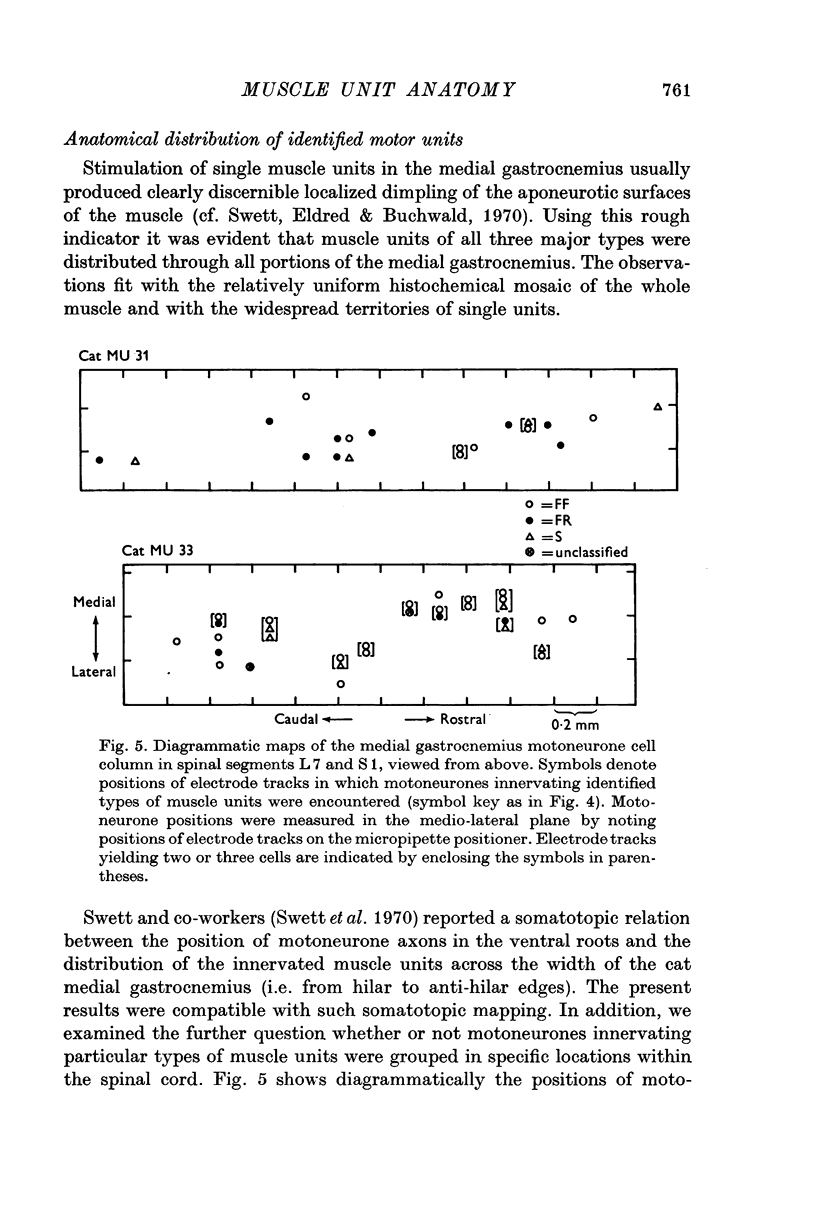Abstract
1. Muscle fibres belonging to single motor units of identified type were studied in frozen sections of cat medial and lateral gastrocnemius muscles. Reconstruction of the distribution of fibres in individual units showed that the territories of all three physiological types present in the cat medial gastrocnemius were quite extensive. Within its territory, fibres belonging to the studied unit were distributed more or less uniformly without localized collections. The density of unit fibres suggests that, in cat medial gastrocnemius, a given region of the muscle may be shared by as many as fifty different muscle units.
2. Direct determination of innervation ratios in identified muscle units required complete reconstruction of the three-dimensional distribution of unit fibres within the whole medial gastrocnemius. Satisfactory results were obtained with two type FF units and one type FR unit.
3. Indirect estimates of the average innervation ratios expected for muscle units of different physiological type were obtained using counts of muscle fibres with characteristic histochemical profiles and data on relative frequencies of motor units of known type in the medial gastrocnemius unit pool. Such indirect estimates of innervation ratios agreed with the results of direct fibre counts in identified units for types FF and FR muscle units. Taken in sum, the available evidence suggests that an average muscle unit in the cat medial gastrocnemius contains between 400 and 800 muscle fibres, irrespective of physiological type.
4. Tension production by single muscle units depends on a number of factors, including innervation ratio, the cross-sectional areas of unit fibres and the specific tension outputs of the unit fibres. The present results suggest that the specific tension output of gastrocnemius type S unit muscle fibres is considerably smaller (about 0·6 kg/cm2) than in either FF units (about 1·5-2·0 kg/cm2) or type FR units (2·6-2·9 kg/cm2).
Full text
PDF
















Selected References
These references are in PubMed. This may not be the complete list of references from this article.
- Ariano M. A., Armstrong R. B., Edgerton V. R. Hindlimb muscle fiber populations of five mammals. J Histochem Cytochem. 1973 Jan;21(1):51–55. doi: 10.1177/21.1.51. [DOI] [PubMed] [Google Scholar]
- Bridgman C. F. The structure of tendon organs in the cat: a proposed mechanism for responding to muscle tension. Anat Rec. 1968 Oct;162(2):209–220. doi: 10.1002/ar.1091620208. [DOI] [PubMed] [Google Scholar]
- Burke R. E., Levine D. N., Tsairis P., Zajac F. E., 3rd Physiological types and histochemical profiles in motor units of the cat gastrocnemius. J Physiol. 1973 Nov;234(3):723–748. doi: 10.1113/jphysiol.1973.sp010369. [DOI] [PMC free article] [PubMed] [Google Scholar]
- Burke R. E. Motor unit types of cat triceps surae muscle. J Physiol. 1967 Nov;193(1):141–160. doi: 10.1113/jphysiol.1967.sp008348. [DOI] [PMC free article] [PubMed] [Google Scholar]
- Close R. I. Dynamic properties of mammalian skeletal muscles. Physiol Rev. 1972 Jan;52(1):129–197. doi: 10.1152/physrev.1972.52.1.129. [DOI] [PubMed] [Google Scholar]
- Edgerton V. R., Barnard R. J., Peter J. B., Simpson D. R., Gillespie C. A. Response of muscle glycogen and phosphorylase to electrical stimulation in trained and nontrained guinea pigs. Exp Neurol. 1970 Apr;27(1):46–56. doi: 10.1016/0014-4886(70)90200-1. [DOI] [PubMed] [Google Scholar]
- FEINSTEIN B., LINDEGARD B., NYMAN E., WOHLFART G. Morphologic studies of motor units in normal human muscles. Acta Anat (Basel) 1955;23(2):127–142. doi: 10.1159/000140989. [DOI] [PubMed] [Google Scholar]
- HENNEMAN E., OLSON C. B. RELATIONS BETWEEN STRUCTURE AND FUNCTION IN THE DESIGN OF SKELETAL MUSCLES. J Neurophysiol. 1965 May;28:581–598. doi: 10.1152/jn.1965.28.3.581. [DOI] [PubMed] [Google Scholar]
- Houk J., Henneman E. Responses of Golgi tendon organs to active contractions of the soleus muscle of the cat. J Neurophysiol. 1967 May;30(3):466–481. doi: 10.1152/jn.1967.30.3.466. [DOI] [PubMed] [Google Scholar]
- Knott S., Lewis D. M., Luck J. C. Motor unit areas in a cat limb muscle. Exp Neurol. 1971 Mar;30(3):475–483. doi: 10.1016/0014-4886(71)90148-8. [DOI] [PubMed] [Google Scholar]
- Kugelberg E., Edström L. Differential histochemical effects of muscle contractions on phosphorylase and glycogen in various types of fibres: relation to fatigue. J Neurol Neurosurg Psychiatry. 1968 Oct;31(5):415–423. doi: 10.1136/jnnp.31.5.415. [DOI] [PMC free article] [PubMed] [Google Scholar]
- MCPHEDRAN A. M., WUERKER R. B., HENNEMAN E. PROPERTIES OF MOTOR UNITS IN A HETEROGENEOUS PALE MUSCLE (M. GASTROCNEMIUS) OF THE CAT. J Neurophysiol. 1965 Jan;28:85–99. doi: 10.1152/jn.1965.28.1.85. [DOI] [PubMed] [Google Scholar]
- Olson C. B., Carpenter D. O., Henneman E. Orderly recruitment of muscle action potentials. Arch Neurol. 1968 Dec;19(6):591–597. doi: 10.1001/archneur.1968.00480060061008. [DOI] [PubMed] [Google Scholar]
- Rosenfalck P., Buchthal F. On the concept of the motor subunit. Int J Neurosci. 1970 Oct;1(1):27–37. doi: 10.3109/00207457009147615. [DOI] [PubMed] [Google Scholar]
- Swett J. E., Eldred E., Buchwald J. S. Somatotopic cord-to-muscle relations in efferent innervation of cat gastrocnemius. Am J Physiol. 1970 Sep;219(3):762–766. doi: 10.1152/ajplegacy.1970.219.3.762. [DOI] [PubMed] [Google Scholar]


